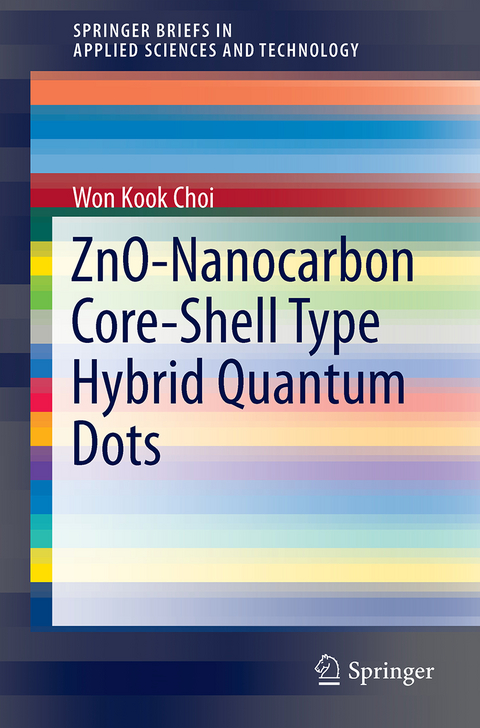
ZnO-Nanocarbon Core-Shell Type Hybrid Quantum Dots
Springer Verlag, Singapore
978-981-10-0979-2 (ISBN)
In the first part of the book, the physical and chemical properties of ZnO and nanocarbons and the state-of-the-art in related research are briefly summarized. In the next part, the 3D conformal coating synthetic processes of ZnO templated nanocarbon hybrid materials such as ZnO-graphene,-C60, single-walled (SWCNT) are introduced with the aid of schematic illustrations. Analysis of their chemical bonding and structure are also presented. In the final section, several applications are presented: UV photovoltaic cells and photoelectrochemical anodes for water splitting using ZnO-C60 and ZnO-graphene, white-light-emitting diodes based on ZnO-graphene quantum dots(GQDs), inverted solar cells using ligand-modified ZnO-graphene QDs, and P(VDF-TrFE) copolymer with mixed with nano-ring SWCNT.
The book describes how strong anchoring bonds between a ZnO core and carbon nanomaterial shell will ultimately prevail over the main drawbacks of ZnO with high charge recombination and poor electrochemical stability in liquid solutions. Due to the moderate energy states and excellent electric properties of the nanocarbons, ultrafast charge carrier transport from the ZnO core to the nanocarbon shell is guaranteed with the use of thephotoluminescence (PL) lifetime measurement.
Given the growing interest and significance of future research in optoelectronic and electrochemical devices applications, the contents are very timely. This book is targeted towards researchers looking for highly efficient metal oxide-nanocarbon hybrid functional materials in the fields of nano-optoelectronics, photoelectrochemistry, energy storage and conversion.
Won Kook Choi received the BS(1984), MS(1986), and Ph.D degree in physics from Yonsei University Korea, in 1993. After that, he joined in Department of Physics, University of Oregon, USA(1993-1994) and Korea Institute of Science and Technology (KIST) as a post-doc in Ceramics Division during 1994-1996. Afterwards he has been worked as a senior and principal research scientist in Thin Film Technology Research Center, Materials Research Division, KIST. During 2012. Feb-2014. Aug, he worked as a head of center in Interface Control Research Center. Since Aug. 2014, he has worked as a director in Materials and Life Science Research Division. He has worked as a professor in Department of Nanomaterials and Nanoscience, Korea University of Science and Technology (KUST). His main research fields are solid surface phenomenon, surface electronic structure study using angle-resolved ultraviolet spectroscopy, and plasma/ion beam surface modification. Since 1998, his research interest was paid on II-VI ZnO semiconductor and LED. In 2008, he reported p-Cu: ZnO/n-SiC heterojunction ZnO-LED emitted cyan-blue color. Recently his group, SNEL (Soft Nano Electronics Laboratory) investigate semiconductor nanoelectronics related to II-VI semiconductor, quantum dot, and van der Waals 2D materials. In 2012, he firstly reported the synthesis of ZnO-graphene core-shell type hybrid quantum dots and realize the emissive ZnO-graphene quantum dot white light-emitting QDLED. Moreover, recently SNEL reported 2D black phosphorous (BP) sheets-based pulsed laser, nonvolatile ferroelectric memory, and charge injection memory.
1 Introduction.- 2 ZnO-Nanocarbon Core-Shell Hybrid Quantum Dots.- 3 Applications of ZnO-Nanocarbon Core-Shell Hybrid Quantum Dots.
| Erscheinungsdatum | 27.06.2016 |
|---|---|
| Reihe/Serie | Nanoscience and Nanotechnology | SpringerBriefs in Applied Sciences and Technology |
| Zusatzinfo | 47 Illustrations, color; 8 Illustrations, black and white; X, 75 p. 55 illus., 47 illus. in color. |
| Verlagsort | Singapore |
| Sprache | englisch |
| Maße | 155 x 235 mm |
| Themenwelt | Naturwissenschaften ► Physik / Astronomie ► Optik |
| Technik ► Maschinenbau | |
| Schlagworte | Nano-ring single-walled CNT • ZnO-C60 photoelectrochemical anode • ZnO–graphene quantum dots for white-light-emitting diodes • ZnO-nanocarbon core-shell hybrid quantum dots • ZnO-templated nanocarbon hybrid synthetic method |
| ISBN-10 | 981-10-0979-1 / 9811009791 |
| ISBN-13 | 978-981-10-0979-2 / 9789811009792 |
| Zustand | Neuware |
| Haben Sie eine Frage zum Produkt? |
aus dem Bereich


